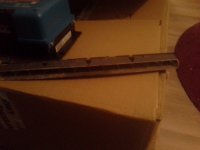Millie Master
Forum Member
When I originally built 'Millie', for the roof lights and windows I initially used Sikaflex when fitting the windows and roof lights, but then after a few months I checked the adhesion of the Sikaflex and although it was sticking like sh-- to the paintwork of the van it didn't appear to have bonded to the plastic of the Seitz windows or the MPK rooflights, so after exchanging a lot of messages with various highly regarded and well respected converters amongst us, I removed all the windows and rooflights , cleaned all the surfaces thoroughly and then refitted everything using black Stixall at the perfect temperature, job done!
Roll on 5and a bit years and I discovered some filthy brown water in the shower room at the back of the van and drips of the same water coming down from the rim of the MPK rooflight in there.
On removing the rooflight, much to my dismay I discovered that all 4 roofing lat tanalised wood spacers I had used had almost totally rotted away, but also that the metal of the roof surrounding the cut out aperture (that I thought had fully treated with rust proofing and paint during the construction) was rapidly rusting away.
So I cleaned everything to nigh on surgical standards, cleaned off and treated all the rust, then applied several coats of a high quality paint. Made new timbers and then bedded down the rooflight onto fresh Stixall......... Job done, I thought!
Roll on until last week when I went into her, only to discover pools of water on the floor along with some very discoloured wood, this time at the next rooflight further into the living space, but this was a rooflight that I thought I had thoroughly checked last year, so it looks like I will be stripping this one out and more than likely carrying out exactly the same process as I did last year.
So my observation or rather question is, do products such as Stixall have a user life, after which they become useless and they start letting in water and if so, is there a better product?
Roll on 5and a bit years and I discovered some filthy brown water in the shower room at the back of the van and drips of the same water coming down from the rim of the MPK rooflight in there.
On removing the rooflight, much to my dismay I discovered that all 4 roofing lat tanalised wood spacers I had used had almost totally rotted away, but also that the metal of the roof surrounding the cut out aperture (that I thought had fully treated with rust proofing and paint during the construction) was rapidly rusting away.
So I cleaned everything to nigh on surgical standards, cleaned off and treated all the rust, then applied several coats of a high quality paint. Made new timbers and then bedded down the rooflight onto fresh Stixall......... Job done, I thought!
Roll on until last week when I went into her, only to discover pools of water on the floor along with some very discoloured wood, this time at the next rooflight further into the living space, but this was a rooflight that I thought I had thoroughly checked last year, so it looks like I will be stripping this one out and more than likely carrying out exactly the same process as I did last year.
So my observation or rather question is, do products such as Stixall have a user life, after which they become useless and they start letting in water and if so, is there a better product?

